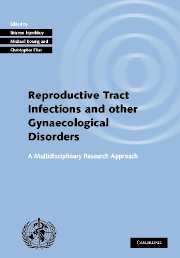 Investigating Reproductive Tract Infections and Other Gynaecological Disorders
Investigating Reproductive Tract Infections and Other Gynaecological Disorders Published online by Cambridge University Press: 07 December 2009
Initial community-based studies in the late 1980s and early 1990s that explored the issue of gynaecological morbidity focused mainly on the clinical assessment of prevalence (Bang et al., 1989; Younis, Khattab and Zurayk, 1993). These early studies faced several methodological challenges in assessing valid prevalence figures due to the sensitive nature of gynaecological morbidity (Koenig et al., 1998; Population Council, 1996). A few studies tested the predictive value of symptoms, such as vaginal discharge, for reproductive tract infections (Bulut et al., 1995; Zurayk and Khattab, 1995). Others tested algorithms as a tool for the diagnosis and management of reproductive tract infections (e.g. Vuylsteke et al., 1993). Still others moved beyond prevalence studies and used qualitative methodological approaches to explore women's perceptions of reproductive tract infections. These methods enabled researchers to explore women's perceptions of the gynaecological problems they encounter in terms of etiology, symptoms, and to some degree the severity of illnesses and health seeking behaviours (Gittelsohn et al., 1994; Oomman, 1996). In spite of a decade of research in the field, several dimensions of gynaecological morbidity remain relatively unexplored and could be more comprehensively investigated using a qualitative research approach. The social, behavioural and biomedical determinants, including sexual and reproductive health-related behaviours and men's roles in women's health, require further elucidation. Similarly, the consequences of gynaecological morbidity, including health seeking behaviour and the impact of morbidity on women's physical and mental health, have not been well described.
To save this book to your Kindle, first ensure [email protected] is added to your Approved Personal Document E-mail List under your Personal Document Settings on the Manage Your Content and Devices page of your Amazon account. Then enter the ‘name’ part of your Kindle email address below. Find out more about saving to your Kindle.
Note you can select to save to either the @free.kindle.com or @kindle.com variations. ‘@free.kindle.com’ emails are free but can only be saved to your device when it is connected to wi-fi. ‘@kindle.com’ emails can be delivered even when you are not connected to wi-fi, but note that service fees apply.
Find out more about the Kindle Personal Document Service.
To save content items to your account, please confirm that you agree to abide by our usage policies. If this is the first time you use this feature, you will be asked to authorise Cambridge Core to connect with your account. Find out more about saving content to Dropbox.
To save content items to your account, please confirm that you agree to abide by our usage policies. If this is the first time you use this feature, you will be asked to authorise Cambridge Core to connect with your account. Find out more about saving content to Google Drive.